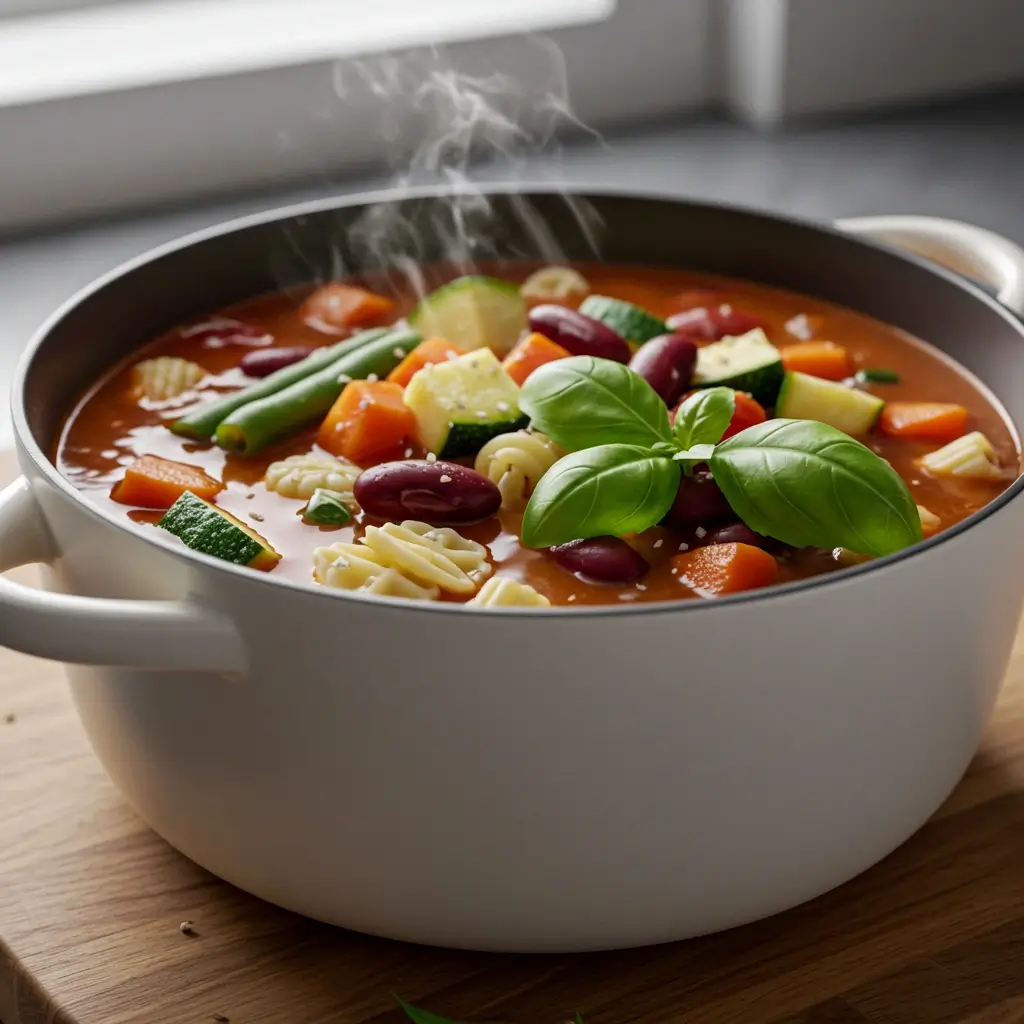Introduction
Minestrone is a traditional Italian soup that is as rich in history as it is in flavor. With its Mediterranean roots, this hearty soup is an excellent way to incorporate a variety of vegetables into your diet. Whether you’re looking for a comforting meal on a chilly day or a nutritious dish that pleases the palate, minestrone is the perfect choice. In this article, we’ll explore a simple yet delicious recipe that brings out the best of this Italian classic. From its wholesome ingredients to the step-by-step cooking process, you’ll discover how easy it is to create a bowl of warmth and flavor that your family will love.
Ingredients
To make a classic minestrone, you’ll need the following ingredients:
- 1 tbsp olive oil
- 1 onion, diced
- 2 carrots, chopped
- 2 celery stalks, chopped
- 2 garlic cloves, minced
- 1 zucchini, diced
- 1 can (14 oz) diced tomatoes
- 4 cups vegetable broth
- 1 can (15 oz) kidney beans, rinsed
- 1 cup green beans, chopped
- 1 cup pasta small shapes
- 1 tsp Italian seasoning
- Salt and pepper to taste
- Fresh basil for garnish
These ingredients come together to create a nourishing soup that’s packed with flavor and nutrition.
Instructions
Follow these simple steps to prepare your minestrone:
- Heat the Olive Oil:
In a large pot over medium heat, add 1 tablespoon of olive oil. - Sauté the Vegetables:
Add the diced onion, chopped carrots, and celery. Sauté for about 5 minutes until the vegetables are soft and the onions are translucent. - Add Garlic and Zucchini:
Stir in the minced garlic and diced zucchini. Cook for another 2 minutes, allowing the flavors to meld together. - Incorporate Tomatoes and Broth:
Pour in the can of diced tomatoes and 4 cups of vegetable broth. Bring the mixture to a boil. - Add Beans, Pasta, and Seasoning:
Add the rinsed kidney beans, chopped green beans, small pasta shapes, and 1 teaspoon of Italian seasoning. Reduce the heat and let the soup simmer for 10-15 minutes, or until the pasta is cooked to your liking. - Season and Serve:
Season the soup with salt and pepper to taste. Serve hot, garnished with fresh basil for an added burst of flavor.
This recipe is not only easy to make but also quick, taking just 30 minutes from start to finish.
Nutrition Facts
Minestrone is a low-calorie, nutrient-dense meal that’s perfect for anyone looking to eat healthily. Here are the nutrition facts per serving:
- Calories: 180
- Protein: 8g
- Carbs: 34g
- Fat: 3g
- Fiber: 7g
This soup is an excellent source of fiber, protein, and essential nutrients, making it a wholesome addition to your meal plan.
How to Serve Minestrone
Minestrone, a hearty and robust Italian soup, is incredibly versatile, allowing for a variety of serving options that cater to different occasions and preferences. Here’s a comprehensive look at how to serve this beloved dish:
As a Main Course
When serving minestrone as a main course, consider enhancing the meal with complementary sides that elevate the dining experience.
- Crusty Bread: A loaf of fresh, crusty bread—such as a rustic Italian ciabatta or sourdough—pairs beautifully with minestrone. The bread can be used to scoop up the soup, adding a satisfying texture and flavor contrast. For added indulgence, serve the bread warm with a side of olive oil or a spread of herb-infused butter for dipping.
- Side Salad: A light, refreshing side salad can balance the hearty nature of minestrone. A simple arugula salad dressed with lemon vinaigrette or a classic Caesar salad can provide a nice contrast. Adding elements such as cherry tomatoes, shaved parmesan, and a sprinkle of nuts can enhance the salad’s flavor profile, making the meal more vibrant.
- Grated Cheese: A sprinkle of freshly grated Parmesan or Pecorino Romano cheese on top of each bowl of minestrone can add a rich, savory note. Serve a small bowl of cheese alongside the soup, allowing guests to customize their bowls to their liking.
As an Appetizer
Minestrone can also be served in smaller portions, making it an excellent appetizer to set the stage for a delightful Italian meal.
- Portion Control: When serving as a starter, consider ladling the soup into smaller bowls or cups, allowing guests to enjoy a taste without overwhelming their appetites. A half-cup serving is often sufficient to whet the appetite.
- Garnishing: Elevate the presentation by garnishing with fresh basil or parsley, a drizzle of high-quality olive oil, or even a sprinkle of red pepper flakes for those who enjoy a bit of heat. This not only enhances the visual appeal but also adds a burst of flavor.
- Pairing with Antipasto: Minestrone can be served alongside a platter of antipasto, including cured meats, olives, marinated vegetables, and cheeses. This combination creates a delightful start to the meal that showcases various textures and flavors typical of Italian cuisine.
For Meal Prep
Minestrone is an ideal dish for meal preparation due to its robust flavors and ease of storage.
- Storage Tips: After preparing your minestrone, allow it to cool completely before transferring it to airtight containers. It can be refrigerated for up to five days without losing its flavor or texture. When storing, consider portioning it into individual servings for easy reheating throughout the week.
- Freezing: For longer storage, minestrone can be frozen for up to three months. To freeze, ensure that the soup is cooled and packed in freezer-safe containers or resealable bags, leaving some space for expansion. When ready to enjoy, simply thaw overnight in the refrigerator and reheat on the stovetop or in the microwave.
- Reheating Tips: When reheating minestrone, add a splash of vegetable broth or water to restore its original consistency, as soups tend to thicken when stored. Heat gently over low to medium heat to prevent the ingredients from becoming mushy, stirring occasionally until warmed through.
- Customization: One of the joys of minestrone is its adaptability. Feel free to customize your batch based on what vegetables you have on hand or your dietary preferences. Adding extra greens, legumes, or grains such as quinoa or barley can boost the nutritional value, making it an even more satisfying meal prep option.
In summary, minestrone is not only a comforting and delicious dish but also an incredibly adaptable one. Whether served as a hearty main course, a delightful appetizer, or a convenient meal prep option, it brings warmth and satisfaction to any dining occasion.
Enhance the dining experience by pairing the soup with a glass of your favorite Italian wine.
Additional Tips for an Enhanced Minestrone Experience
To elevate your minestrone and tailor it to your tastes, here are some detailed tips that will help you customize, enhance, and perfect this classic Italian soup.
Customize the Vegetables
One of the joys of making minestrone is its adaptability. The recipe can be easily modified based on seasonal availability or your personal preferences. Consider the following options:
- Seasonal Vegetables: In the spring, incorporate fresh peas and asparagus for a vibrant touch. In the fall, diced butternut squash or sweet potatoes can add a comforting sweetness.
- Leafy Greens: Adding greens not only boosts nutrition but also enhances the soup’s texture and flavor. Spinach and kale are fantastic options; kale will add a hearty chewiness while spinach will wilt quickly, melding seamlessly into the broth.
- Bell Peppers: These can add a sweet crunch and a pop of color. Red, yellow, and orange bell peppers bring different levels of sweetness, while green peppers offer a slightly bitter edge that can complement the soup’s overall flavor.
- Other Vegetables: Don’t hesitate to experiment with zucchini, asparagus, green beans, or even mushrooms. Each vegetable brings its own unique flavor and texture, contributing to a more complex and satisfying dish.
Use Whole-Grain Pasta
For a healthier twist on your minestrone, opt for whole-grain pasta instead of traditional semolina pasta. Whole-grain options are not only higher in fiber, which aids digestion and promotes satiety, but they also contain more vitamins and minerals. When selecting whole-grain pasta, consider the following:
- Cooking Time: Whole-grain pasta may require a slightly longer cooking time compared to regular pasta, so be sure to adjust your cooking process accordingly to ensure the pasta is perfectly al dente.
- Variety: Experiment with different shapes such as whole-grain elbow macaroni, rotini, or even whole-grain orzo. Each shape can add a different mouthfeel and visual appeal to your minestrone.
Vegan-Friendly Options
While this minestrone recipe is naturally vegan, you can easily adapt it based on dietary preferences. If you’re looking to cater to both vegan and vegetarian palates:
- Parmesan Cheese: A sprinkle of freshly grated Parmesan cheese just before serving can add a rich, savory depth to the soup. For a true vegetarian version, consider using a high-quality aged Parmesan, which has a robust flavor that complements the soup beautifully.
- Nutritional Yeast: For a vegan-friendly alternative, nutritional yeast can be sprinkled on top before serving. This ingredient adds a cheesy flavor without the dairy, and it’s packed with B vitamins, making it a nutritious addition.
Thicken the Soup
If you enjoy a heartier, thicker soup, consider these approaches:
- Mashing Beans: Before adding kidney beans to the pot, reserve a portion and mash them using a fork or a potato masher. Stir the mashed beans back into the soup to create a creamier texture while maintaining the rustic feel of minestrone.
- Add Pureed Vegetables: Another method to thicken the soup is to puree a portion of the vegetables. Simply blend a cup or two of the cooked soup in a blender until smooth and return it to the pot. This not only thickens the soup but also enriches the flavor profile.
- Use Starch: If you’re looking for a quick fix, consider adding a small amount of cornstarch or arrowroot mixed with cold water to the simmering soup. This will thicken the broth without altering the flavor.
Final Thoughts
With these additional tips, your minestrone can transform from a simple soup into a versatile, nutritious meal that reflects your personal taste preferences and dietary needs. Enjoy experimenting with different ingredients and techniques to craft the perfect bowl of minestrone that warms both body and soul. Whether you’re serving it as a comforting weeknight dinner or a vibrant dish for guests, each bowl can be a unique culinary creation that celebrates the beauty of fresh, wholesome ingredients.
These tips will help you tailor the soup to your taste and dietary needs.
FAQs
Q: Can I freeze minestrone soup?
A: Yes, minestrone freezes well. Let it cool completely before transferring it to airtight containers. It can be stored in the freezer for up to 3 months. Thaw in the refrigerator before reheating.
Q: What other beans can I use?
A: You can replace kidney beans with cannellini beans, chickpeas, or any other beans you prefer.
Q: Can I use chicken broth instead of vegetable broth?
A: Yes, chicken broth can be used if you’re not following a vegetarian or vegan diet. It will add a different flavor profile to the soup.
Q: How do I reheat leftovers?
A: Reheat the soup on the stovetop over medium heat until warmed through. You may need to add a little water or broth if the soup has thickened in the fridge.
These answers should help address common concerns and questions regarding the preparation and storage of minestrone.
Conclusion
Minestrone is more than just a soup; it’s a celebration of fresh, wholesome ingredients that come together to create a dish that’s both satisfying and nutritious. Perfect for any occasion, this Italian classic can be customized to suit your taste and dietary preferences. With its rich flavors and hearty texture, minestrone is sure to become a staple in your recipe collection. Whether you’re a seasoned cook or a kitchen novice, this easy-to-follow recipe will guide you in creating a meal that’s as delightful to make as it is to eat. So gather your ingredients, and enjoy the comforting warmth of homemade minestrone.
The beauty of minestrone lies in its versatility. It’s a great way to use up leftover vegetables or seasonal produce, making it an ideal choice for reducing food waste while still enjoying a flavorful dish. The combination of vegetables, beans, and pasta in a savory broth makes it a well-rounded meal that is both filling and nourishing. Add a sprinkle of Parmesan cheese or a dash of olive oil to elevate the flavors and bring a touch of richness. Minestrone is also easy to make in advance, allowing the flavors to deepen over time. Whether enjoyed as a starter or a main course, this soup is perfect for feeding a crowd or for cozy meals at home.
Print
Minestrone Recipe
Ingredients
- 1 tbsp olive oil
- 1 onion, diced
- 2 carrots, chopped
- 2 celery stalks, chopped
- 2 garlic cloves, minced
- 1 zucchini, diced
- 1 can (14 oz) diced tomatoes
- 4 cups vegetable broth
- 1 can (15 oz) kidney beans, rinsed
- 1 cup green beans, chopped
- 1 cup pasta small shapes
- 1 tsp Italian seasoning
- Salt and pepper to taste
- Fresh basil for garnish
Instructions
- Heat the Olive Oil:
In a large pot over medium heat, add 1 tablespoon of olive oil. - Sauté the Vegetables:
Add the diced onion, chopped carrots, and celery. Sauté for about 5 minutes until the vegetables are soft and the onions are translucent. - Add Garlic and Zucchini:
Stir in the minced garlic and diced zucchini. Cook for another 2 minutes, allowing the flavors to meld together. - Incorporate Tomatoes and Broth:
Pour in the can of diced tomatoes and 4 cups of vegetable broth. Bring the mixture to a boil. - Add Beans, Pasta, and Seasoning:
Add the rinsed kidney beans, chopped green beans, small pasta shapes, and 1 teaspoon of Italian seasoning. Reduce the heat and let the soup simmer for 10-15 minutes, or until the pasta is cooked to your liking. - Season and Serve:
Season the soup with salt and pepper to taste. Serve hot, garnished with fresh basil for an added burst of flavor.
Nutrition
- Serving Size: one normal portion
- Calories: 180
- Fat: 3g
- Carbohydrates: 34g
- Fiber: 7g
- Protein: 8g





